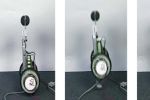Flying Cars Made Easy
Not only is this a beautiful demonstration of how much thrust can be generated by a fire hose, it also gives us a glimpse into what firemen might be doing while waiting around at the station when no one's looking. It's also a beautiful demonstration of the principles of rocket propulsion, Newton's third law, and the law of conservation of momentum.
First, let's calculate the approximate thrust generated by each fire hose. Because the hoses are able to accelerate the compact car off of the ground, the combined maximum thrust of the ten hoses must be somewhat greater than the weight of the car. Assuming that the car is on the lighter side -- say 2,000 pounds or so -- then each hose produces a thrust of at least 200 pounds. No wonder firemen have to brace themselves solidly in place when operating one of these babies.
It's extremely aesthetically pleasing to see that car hovering over the parking lot like some exotic alien flying saucer, and the demonstration beautifully illustrates our old friend Newton's third law with its application to rocket flight. Remember: if you push on something, it pushes you back with an equal force in the opposite direction. If you want to accelerate a rocket, just expel something forcefully (rocket fuel, for example) out of the back end. That fuel is going to push back on you, accelerating you the opposite way. While fire stations may not have rocket fuel handy, why not use water and compressed air (just like with the water bottle rockets we were looking at a few weeks back) for fuel?
We can also explain the "magic hovering water-powered fire station car" in terms of conservation of momentum as follows: Let's include the car and the water hoses as part of a single system. According to the principle of conservation of momentum, in the absence of external forces on a system the total momentum of the system will remain constant.
Before the water is ejected and no cars are flying anywhere, the total momentum of the system is zero. But after the water is ejected, the total momentum must still be zero, because the force acting to expel the water, and the force the water exerts back on the surrounding hose and car, are both inside the system and cancel out. This means that the downward momentum that the expelled water gains as its forced out of the hoses must be cancelled by the upward momentum of the car. Thus the car is "driven" upwards. Notice how the principle of conservation of momentum is directly connected to, and in fact a result of, Newton's third law!
Remember, kids, this may look like fun, but lifting cars with fire hoses can be a potentially dangerous activity. We recommend that you don't try this at home!
Adam Weiner is the author of Don't Try This at Home! The Physics of Hollywood Movies.
1 Comment
Popular Tags
SciTech
Regular Features

Featured
SciTech
Science Confirms the Obvious 2008
The findings may be no-brainers (yes, you do get sick in winter), but these studies uncover hidden truths in conventional wisdomBuilding the Real Iron Man
While audiences flood theaters this month to see the comic-book-inspired Iron Man, a real-life mad genius toils in a secret mountain lab to make the mechanical superhuman more than just a fantasy with the XOS Exoskeleton
Popular on Popsci
Most Viewed
Most Commented
SciTech
- Sorry Ladies, Those Shots Aren't Sexy
- The Agony of the Heat
- Does Your Taste in Music Reflect Your Intelligence?
- Can People Safely Eat Cat Food?
- Drinking Adds to Cancer Risk
- Friday You Tube Hit: The Most Amazing Miss Ever!
- R U Down Wiv Txt Slang?
- The Periodic Table: Older Than It's Ever Been
- Energy Drinks Kill Our Buzz
- Flying Cars Made Easy









Comments
Looks cool, but it sucks how they have all that water to waste on propelling their cars while we in Aus are still under water restrictions!
0 out of 0 people found this comment helpful